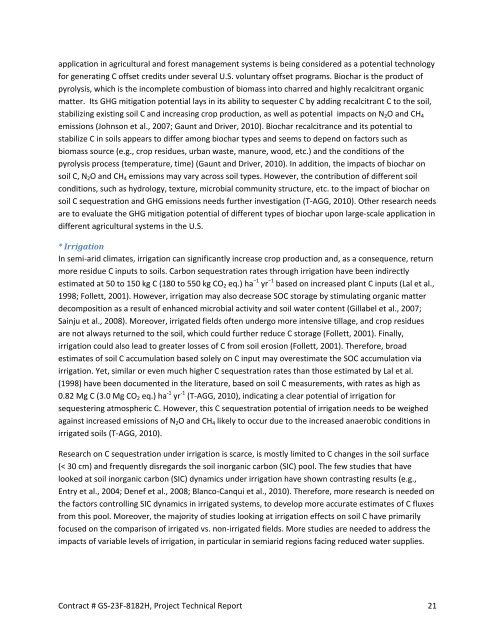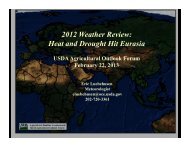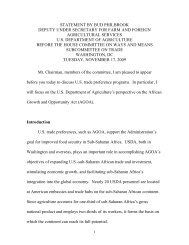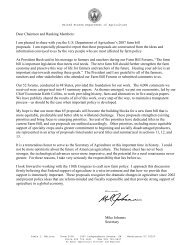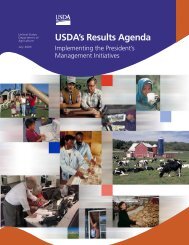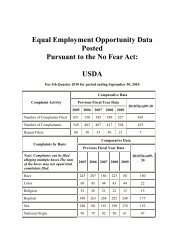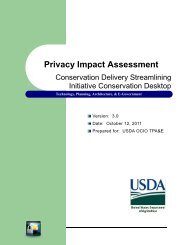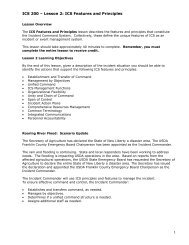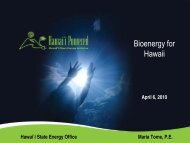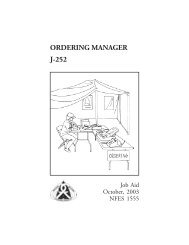Greenhouse Gas Emissions from U.S. Agriculture and Forestry: A ...
Greenhouse Gas Emissions from U.S. Agriculture and Forestry: A ...
Greenhouse Gas Emissions from U.S. Agriculture and Forestry: A ...
You also want an ePaper? Increase the reach of your titles
YUMPU automatically turns print PDFs into web optimized ePapers that Google loves.
application in agricultural <strong>and</strong> forest management systems is being considered as a potential technology<br />
for generating C offset credits under several U.S. voluntary offset programs. Biochar is the product of<br />
pyrolysis, which is the incomplete combustion of biomass into charred <strong>and</strong> highly recalcitrant organic<br />
matter. Its GHG mitigation potential lays in its ability to sequester C by adding recalcitrant C to the soil,<br />
stabilizing existing soil C <strong>and</strong> increasing crop production, as well as potential impacts on N2O <strong>and</strong> CH4<br />
emissions (Johnson et al., 2007; Gaunt <strong>and</strong> Driver, 2010). Biochar recalcitrance <strong>and</strong> its potential to<br />
stabilize C in soils appears to differ among biochar types <strong>and</strong> seems to depend on factors such as<br />
biomass source (e.g., crop residues, urban waste, manure, wood, etc.) <strong>and</strong> the conditions of the<br />
pyrolysis process (temperature, time) (Gaunt <strong>and</strong> Driver, 2010). In addition, the impacts of biochar on<br />
soil C, N2O <strong>and</strong> CH4 emissions may vary across soil types. However, the contribution of different soil<br />
conditions, such as hydrology, texture, microbial community structure, etc. to the impact of biochar on<br />
soil C sequestration <strong>and</strong> GHG emissions needs further investigation (T‐AGG, 2010). Other research needs<br />
are to evaluate the GHG mitigation potential of different types of biochar upon large‐scale application in<br />
different agricultural systems in the U.S.<br />
* Irrigation<br />
In semi‐arid climates, irrigation can significantly increase crop production <strong>and</strong>, as a consequence, return<br />
more residue C inputs to soils. Carbon sequestration rates through irrigation have been indirectly<br />
estimated at 50 to 150 kg C (180 to 550 kg CO2 eq.) ha −1 yr −1 based on increased plant C inputs (Lal et al.,<br />
1998; Follett, 2001). However, irrigation may also decrease SOC storage by stimulating organic matter<br />
decomposition as a result of enhanced microbial activity <strong>and</strong> soil water content (Gillabel et al., 2007;<br />
Sainju et al., 2008). Moreover, irrigated fields often undergo more intensive tillage, <strong>and</strong> crop residues<br />
are not always returned to the soil, which could further reduce C storage (Follett, 2001). Finally,<br />
irrigation could also lead to greater losses of C <strong>from</strong> soil erosion (Follett, 2001). Therefore, broad<br />
estimates of soil C accumulation based solely on C input may overestimate the SOC accumulation via<br />
irrigation. Yet, similar or even much higher C sequestration rates than those estimated by Lal et al.<br />
(1998) have been documented in the literature, based on soil C measurements, with rates as high as<br />
0.82 Mg C (3.0 Mg CO2 eq.) ha ‐1 yr ‐1 (T‐AGG, 2010), indicating a clear potential of irrigation for<br />
sequestering atmospheric C. However, this C sequestration potential of irrigation needs to be weighed<br />
against increased emissions of N2O <strong>and</strong> CH4 likely to occur due to the increased anaerobic conditions in<br />
irrigated soils (T‐AGG, 2010).<br />
Research on C sequestration under irrigation is scarce, is mostly limited to C changes in the soil surface<br />
(< 30 cm) <strong>and</strong> frequently disregards the soil inorganic carbon (SIC) pool. The few studies that have<br />
looked at soil inorganic carbon (SIC) dynamics under irrigation have shown contrasting results (e.g.,<br />
Entry et al., 2004; Denef et al., 2008; Blanco‐Canqui et al., 2010). Therefore, more research is needed on<br />
the factors controlling SIC dynamics in irrigated systems, to develop more accurate estimates of C fluxes<br />
<strong>from</strong> this pool. Moreover, the majority of studies looking at irrigation effects on soil C have primarily<br />
focused on the comparison of irrigated vs. non‐irrigated fields. More studies are needed to address the<br />
impacts of variable levels of irrigation, in particular in semiarid regions facing reduced water supplies.<br />
Contract # GS‐23F‐8182H, Project Technical Report 21


